Email Marketing
Onboarding Email Examples for More Successful and Sticky Customers
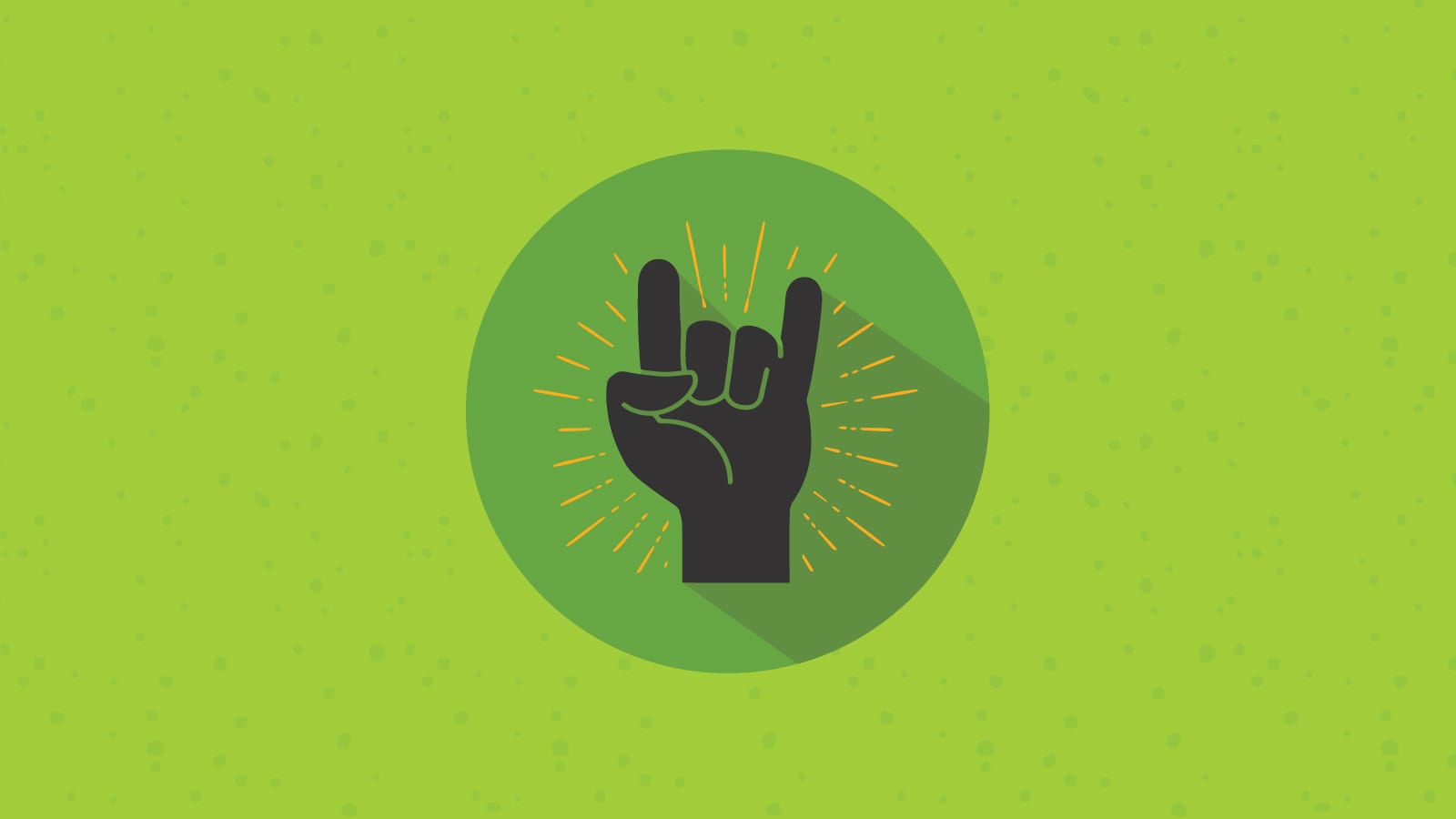
Email Marketing

Put yourself in the shoes of one of your new customers. You’ve finally whipped out your credit card, punched in all the numbers, and hit purchase. Phew. You can’t wait to get started. You’ve heard so much about this thing from about a hundred different emails, right?
But after you pay… Crickets.
We’re willing to bet this has happened to you too. Maybe you’ve purchased a new piece of software and were left wondering how to install it or finally caved and bought that pair of shoes you’ve been eyeing only to wonder if the sale went through at all.
You never want your customers to ask, “What now?” The customer journey doesn’t end after a purchase.
No matter what kind of product you offer, you need to give your newest customers a little direction. Onboarding emails are a great way to help customers be successful right away, give them peace of mind they made the right decision by choosing you, and set them up to stick around. Here’s what you need to know:
Onboarding emails are a sequence of email campaigns sent to new customers after they make a purchase. While every sequence looks different, most companies send 3-10 emails at various intervals with information about how to get started with their purchase, information on additional features, and links to customer-specific information, such as FAQs or a link to the help desk.
The point of sending onboarding emails to new customers is to ensure a smooth transition into using your products and services. Of course, the benefits of an onboarding sequence go much further than that.
Putting together an onboarding sequence takes time (and a little CRM magic) but it pays off in big ways for your business. Here’s how:
The most important reason to invest the time and energy into an onboarding sequence is that it helps improve retention and reduce churn. If customers aren’t impressed right away, they’re much less likely to continue to use your product. But a lot of that comes from not understanding how to use it, or not knowing where to start. That initial friction is enough to lose customers— the average churn for SaaS brands is 5%, and a “good” rate is 3%. Check out a complete list of average customer churn rates by industry.
An onboarding sequence can help establish a stronger relationship right away.
Often, we think of upsell/crossell efforts as something that takes place well after onboarding. But your onboarding emails can actually be a great place to plant that seed. You’ll want to keep it with a light touch, of course, since they only just got started. But showing off customer testimonials, promoting additional features, or just giving information about how to get in touch with the success team helps grease that flywheel for the future.
Beyond bugs, new customers often take up the most inquiries for customer support. Whether you have an account management team or not, an onboarding sequence gives your customers a place to land. That way, you’re answering questions before they happen (and giving them resources to solve their problems on their own.)
This isn’t the first time your customers are hearing from you—after all, they’ve gone through the entire purchase process—but it is a great chance to show them the best of what you have to offer. You’ve made plenty of promises in the course of your marketing efforts, and now it’s time to deliver.
Customers today have plenty of choice when it comes to their products and services. They chose you. This is likely the first interaction you’ll have with them as your customer, so it’s a great place to make a real impression that you care about their success. If you want to create the kind of customers that purchase again and again—putting in the effort at the beginning really matters.
So, do you absolutely need an onboarding email sequence? If your product is straightforward, it’s probably enough to send one or two welcome emails in addition to your transactional email for the sale. Otherwise, automating an onboarding series can be especially useful:
A great onboarding sequence isn’t just a welcome email—each message should meet the customer where they are in the process and deliver the information they need to progress to the next step. Here are a few favorites from our inboxes:

Every onboarding sequence starts with a welcome email. But your welcome email doesn’t need to have every single piece of information crammed into it. Instead, this example from Niice does a great job of introducing the brand and top value props. With a gentle reminder that you can reach out to support if you need anything, plus a clear call to action to get started, this is a great template for any industry.
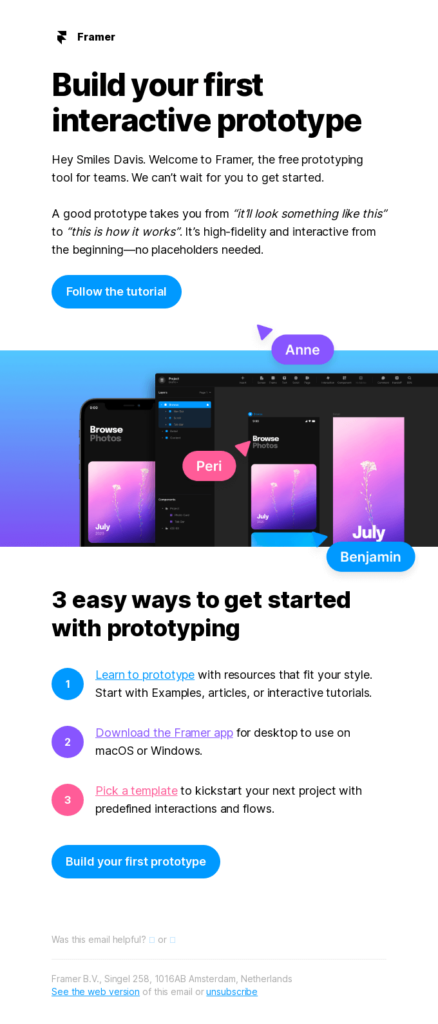
Trying something new can be hard, especially if it’s a critical piece of software for your job. Especially if there’s a learning curve involved, breaking steps down to give your new customers a sense of pride and ownership can go a long way toward building a good relationship. This how-to email from Framer offers a quick tutorial on how to get started with their product without getting bogged down in too many details. This is a great email to send as the second or third in a series, ideally in the first few days.
Of course, you can choose to keep email onboarding content high level and straightforward, but you can also link to more in-depth tutorials and customer support documentation.

Once a customer completes one task, it’s important to keep them moving forward through the product.This email from Zapier does a great job of explaining a key piece of terminology for their product (“zaps”) while building on behavior the customer has already shown.
Once they complete their first zap, they receive this email:
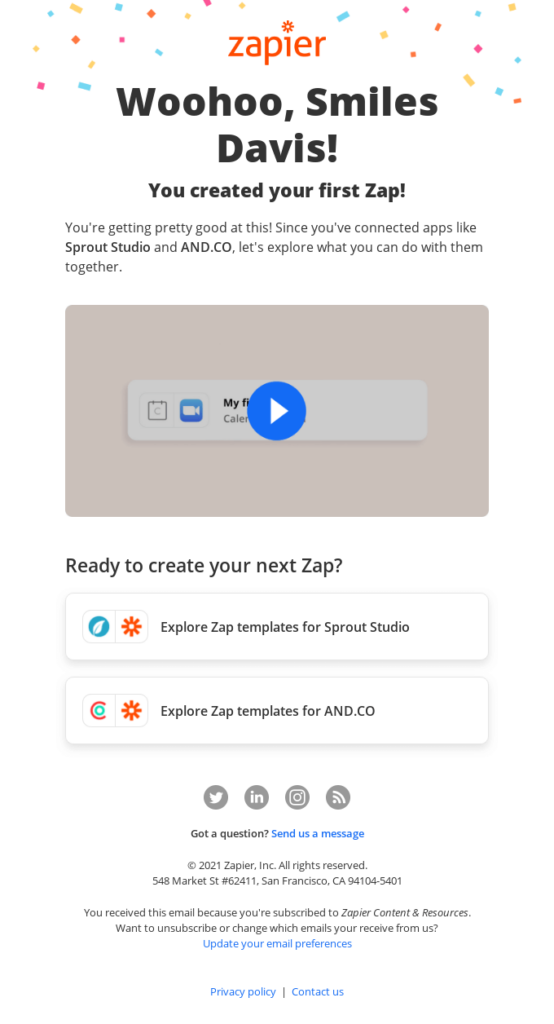
The more connected a customer is, the more likely they’ll see value out of their product. Encouraging key milestones like this, both before and after they take place, helps nudge customers in the right direction. You can do the same via behavioral triggers in-product.
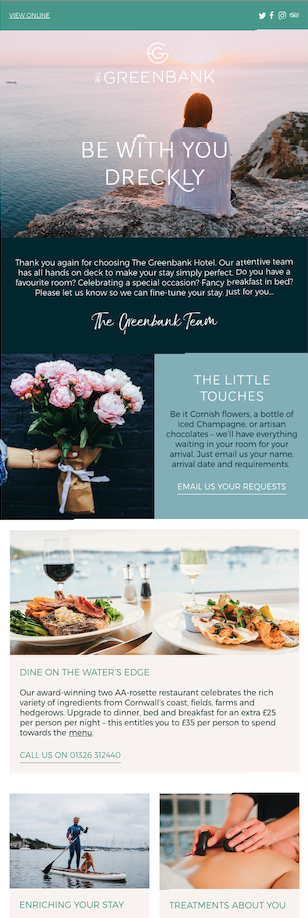
Sometimes, customers do need or want a little help. This email showcases the hospitality guests can expect at the Greenbank Hotel, inviting newly booked guests to reach out to their team to customize their visit. By offering customers a chance to speak with you—whether it’s an account manager to fine-tune their product setup or a quick check-in via chat—can make a difference in their overall impression during the first two weeks.
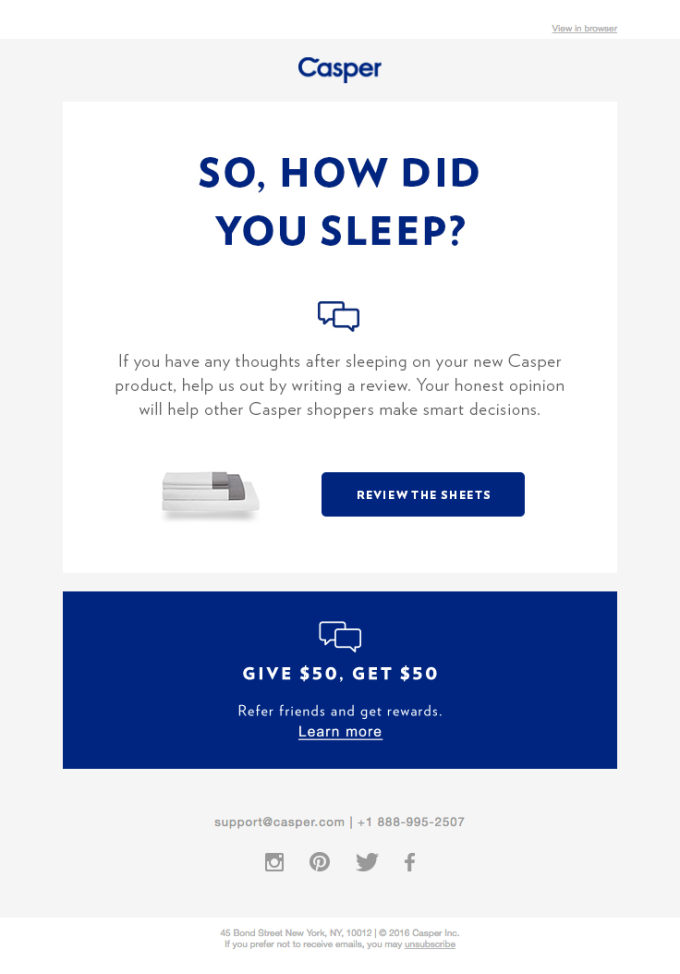
If you’re going to ask a customer to review your product, do it sooner than later. But you don’t want to ask them too soon—otherwise, they won’t have had a chance to try it. This email from Casper strikes a great balance. Sent around the 30-day mark, this email gets to the point quickly, asking for customers to leave a review. Your timeline will depend on your product or service.
So, how can you implement onboarding emails like these? Here’s a few things to keep in mind:
The most important part of your onboarding emails doesn’t have anything to do with what’s inside them. It’s the timing.
Before you launch an onboarding email sequence, you need to map out the entire customer lifecycle once they complete a purchase. Think about each piece of information that they will need and when they need to receive it. This is a great chance to sit down with your customer success and support teams to figure out any patterns in the inquiries they receive, or what they go over in the first account management meeting.
From there, you can make a plan for your email series.
In terms of the content within your onboarding emails, focus on the customer. Put yourself in their shoes. If you’re not sure what that looks like, consider an email flow like this:
Your onboarding sequence can be as long as you’d like. Generally, brands stick with 3-5 emails in the first few weeks and then pepper additional onboarding content throughout the rest of the 30 days or based on behavior.
While it’s good to sketch out an overall onboarding flow, it’s also important to add product-specific triggers into your email series if it’s possible to do so. Work with your product team to understand key milestones that lead to stronger retention and nurture those. For example, celebrate the first time they complete a certain task, start a new project, or invite a new user.
The milestones will vary dramatically based on your product—but your team knows what leads to a customer with high lifetime value (LTV) vs. one that churns. The more you can hype up your new customers and lead them down a path of engagement with your product, the better off you’ll be.
We’re not talking about “first name,” though that’s a good place to start.
Part of what makes product triggers so valuable is that they avoid awkward inbox situations for your new customers, like encouraging them to add their billing information when they’ve already done so.
One way to build personalization is through a quick onboarding survey within your email sequence. Ask what they hope to get out of the product, any goals or frustrations, and a few demographics like location or company size if you don’t have that data elsewhere. Consider using dynamic content tailored to where they are in the customer lifecycle as well. The more you can include personalization—even subtle ways, like through name, title, or company name—the more your new customer will feel connected with your brand.
This is just the beginning of your relationship with your customer. It’s your job to wow them right away. But if you can pull it off, it’s a great opportunity to include a few upsell or crossell messages in your onboarding emails.
For example, you could:
You don’t want to be aggressive in your marketing here. Instead, you’re underlining the ways you can help them even more, or offering additional deals based on their current engagement.
The best way to botch a good first impression? Emails that contain errors or are impossible to read.
That’s where Sinch Email on Acid can help. Our full suite of testing and optimization tools give you the peace of mind that you’re sending flawless emails your subscribers will love. Whether it’s creating an automated onboarding flow or sending one-off campaigns, Email on Acid’s testing and preview features ensure you’ll never send an apology email again.